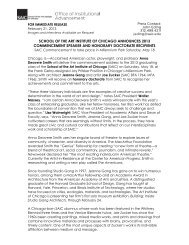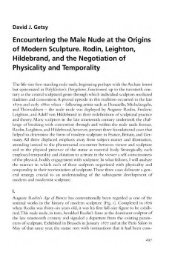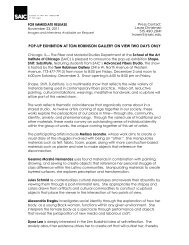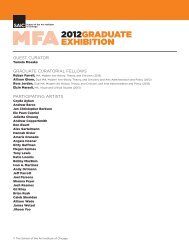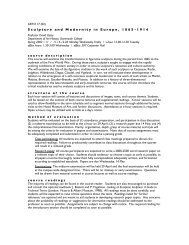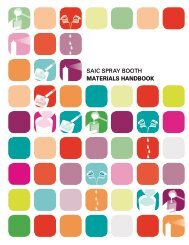i. institutional support and commitment to continuous improvement
i. institutional support and commitment to continuous improvement
i. institutional support and commitment to continuous improvement
Create successful ePaper yourself
Turn your PDF publications into a flip-book with our unique Google optimized e-Paper software.
School of the Art Institute of Chicago<br />
Department of Architecture, Interior Architecture, <strong>and</strong> Designed Objects<br />
Master of Architecture<br />
Master of Architecture with emphasis in Interior Architecture<br />
I. INSTITUTIONAL SUPPORT AND COMMITMENT TO<br />
CONTINUOUS IMPROVEMENT<br />
I.1. IDENTITY AND SELF ASSESSMENT<br />
I.1.1. His<strong>to</strong>ry <strong>and</strong> Mission<br />
The School of the Art Institute of Chicago (SAIC), which predates the lauded museum, the Art Institute<br />
of Chicago (AIC), is an artist-centric institution, founded, run, <strong>and</strong> transformed by the many visual<br />
artists, designers, performers, scholars, <strong>and</strong> architects who have shaped the School. Since 1866, the<br />
vision <strong>and</strong> growth of SAIC has been a reflection of the vanguard <strong>and</strong> myriad trajec<strong>to</strong>ries art has<br />
undertaken. This has lead <strong>to</strong> a flexible curriculum, strongly steeped in the sound scholarship of liberal<br />
arts curricula, that reflects contemporary practice in art <strong>and</strong> design <strong>and</strong> its interface with the world.<br />
A reflection of that ongoing innovation is the department of Architecture, Interior Architecture, <strong>and</strong><br />
Designed Objects (AIADO)—the result of <strong>institutional</strong> efforts <strong>to</strong> strengthen, exp<strong>and</strong>, <strong>and</strong> integrate<br />
its established design programs. Within AIADO’s academic unit (which also provides administrative<br />
<strong>support</strong> for the department of His<strong>to</strong>ric Preservation), the Master of Architecture program offers a<br />
structured degree, while still reflecting the engaged, collaborative nature of SAIC, drawing on the<br />
institution’s his<strong>to</strong>ry <strong>and</strong> other programs <strong>to</strong> explore new systems <strong>and</strong> opportunities for engagement<br />
with architecture in the world.<br />
A) Mission of the institution<br />
Both the mission <strong>and</strong> objectives have served as his<strong>to</strong>rical documents for an institution established<br />
nearly 150 years ago. The Art Institute of Chicago’s corporate charter (Articles of Incorporation) was<br />
originally obtained from the State of Illinois in 1879, <strong>and</strong> the original mission <strong>and</strong> objectives were<br />
found in that charter. The mission was amended in 1925, 1982, <strong>and</strong>, most recently, 2004 when both the<br />
mission <strong>and</strong> objectives were revised <strong>to</strong> more specifically reflect the current nature of the School.<br />
Mission Statement, as revised in 2004<br />
To provide excellence in the delivery of a global education in visual, design, media <strong>and</strong> related<br />
arts, with attendant studies in the his<strong>to</strong>ry <strong>and</strong> theory of those disciplines set within a broad-based<br />
humanistic curriculum in the liberal arts <strong>and</strong> sciences. To provide instruction for this education in a<br />
range of formats: written, spoken, media <strong>and</strong> exhibition-based.<br />
Statement of Objectives, as revised in 2004<br />
To assemble a diverse body of intelligent <strong>and</strong> creative students <strong>and</strong> faculty in an innovative,<br />
transdisciplinary environment designed <strong>to</strong> facilitate <strong>and</strong> encourage the creation <strong>and</strong> discovery of<br />
significant ideas, objects <strong>and</strong> images; <strong>to</strong> provide for the development of individual excellence in the<br />
visual, design, media <strong>and</strong> related arts <strong>and</strong> in relevant professional <strong>and</strong> academic disciplines.<br />
B) His<strong>to</strong>ry of the institution<br />
SAIC is one of the largest <strong>and</strong> oldest visual art <strong>and</strong> design schools in the nation, <strong>and</strong> one of only three<br />
<strong>to</strong> retain their original affiliation with a partner museum. SAIC has evolved from a professional fine art<br />
“museum school” <strong>to</strong> a college of art that, in addition <strong>to</strong> the time-honored study of painting, sculpture,<br />
<strong>and</strong> printmaking, also embraces media <strong>and</strong> time arts; design; <strong>and</strong>, transdisciplinary fields such as visual<br />
<strong>and</strong> critical studies. Studio graduate programs are complemented by degrees offered in art his<strong>to</strong>ry,<br />
theory, <strong>and</strong> criticism; writing; arts administration; visual <strong>and</strong> critical studies; his<strong>to</strong>ric preservation; new<br />
arts journalism; art therapy; <strong>and</strong> art education. A full detailing of the Institution’s corporate structure,<br />
programs, <strong>and</strong> degrees can be found in section 3.11 of the APR.<br />
The School of the Art Institute of Chicago, founded by a small group of Chicago artists in 1866, was<br />
designed after a drawing-based, European academy model that emphasized traditional artmaking<br />
Architecture Program Report | 6



